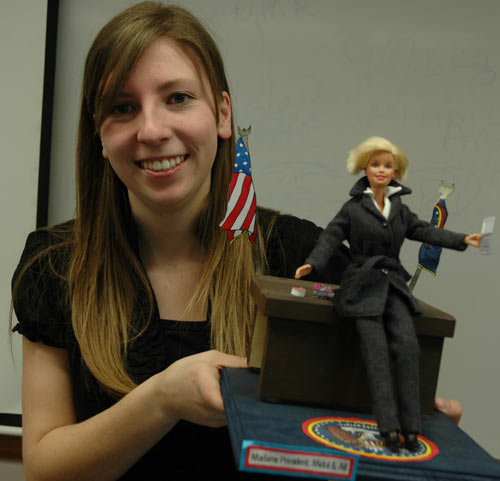Press coverage of woman candidates biased, student researcher finds
November 23rd, 2009 Posted in OpinionLOGAN–For journalism major Kate Reeves, the timing of Sarah Palin’s national tour last week to promote her new book couldn’t have been better. And the national news media cooperated, too, focusing a generally mocking eye once again on the former GOP vice presidential candidate.
 Reeves was scheduled to present her Honors thesis research, which focused on bias in press coverage of woman candidates for major national office, before Palin burst back into the news with the release of her book, Going Rogue.
Reeves was scheduled to present her Honors thesis research, which focused on bias in press coverage of woman candidates for major national office, before Palin burst back into the news with the release of her book, Going Rogue.
In her study of 2008 New York Times editorial coverage, Reeves found bias in how women candidates are framed, treating women like Palin as “novelties,” or worse. She noted that the former vice presidential candidate appears on this week’s Newsweek in short-shorts.
“I think what it comes down to is that the gender issues—the hockey mom thing—becomes the focus, instead of asking more legitimate questions, like about Palin’s positions on foreign policy,” Reeves said. “Everything was framed by her gender.”
Specifically, Reeves, an Honors journalism major, examined all the editorials running in the New York Times that focused on both Palin and her Democratic vice presidential opponent, Joe Biden, during the 2008 election. She also examined Times editorials during the 1984, which featured the only other woman nominated as a major-party vice presidential candidate, Democratic New York Congresswoman Geraldine Ferraro.
“I looked specifically at the number of editorials that covered the candidates and how they were framed by the Times,” Reeves said. “I found that the women were treated differently from the male candidates. They received substantially more coverage and were framed by their gender. The implication of these differences is that the women will have a more difficult time getting elected.”
Reeves, who will graduate from USU in December, outlined her research and findings for a gender and media class taught by JCOM professor Brenda Cooper. Although the students expected that the press had covered Palin and Ferraro differently than their male opponents, Biden and George W. Bush, the level and amount of the bias reflected in the Times editorials surprised many of them.
“Seeing how they bashed Hillary [Clinton] and how they bashed Palin would discourage me from running,” one student said following Reeves’s presentation.
And for Reeves, that’s exactly the problem.
“One of the biggest problems in getting women elected to office is they have an added burden,” Reeves said. “In addition to meeting all the qualifications that the male candidates have to meet, they are also expected to be good wives and mothers and to look great in a pants suit.”
When Democrat Walter Mondale selected Ferraro in 1984 as the first woman to run on a major-party presidential ticket, their GOP opponents, Ronald Reagan and the first George Bush, worried about looking chauvinist and “too male.” In some ways, this problem was even worse when John McCain picked Alaska Gov. Palin as his running mate last year, Reeves said, because of who Sarah Palin is.
Reeves found that both Ferraro and Palin were more likely to be framed in context of family relations in Times editorials, but Palin’s background as a “former beauty queen” and mother of an unmarried, teenaged pregnant daughter contributed to her being the focus of editorial comment fours times more than Bush, three times more often than Biden, and nearly twice as often as Ferraro.
“They treated her as a novelty item,” she said. “They completely attacked her gender.” Among the terms the press used to describe Palin during the 2008 election: “whack job,” “diva,” “McCain’s bulldog”—in addition to references to lipstick on a pig and “hockey mom.”
Male candidates were referred to by their titles—Sen. Biden, for example—but the female candidates were called “Gerry” or “Sarah,” without reference to their professional status.
“These women were framed by their families. They were framed by their homelife,” Reeves found. “The men were framed by the political positions they held, they were framed as people who were qualified.
“If these are the images we are getting, if these are how these candidates are being framed, then this can make it more difficult for female candidates to get elected,” she concluded.
“In order to be fair and equal, if we’re going to say that being a good parent is something that we want in a vice presidential candidate, then let’s look at both candidates parenting skills, whether they’re male or female.”
—Contributing reporters Candice Mattson and Storee Powell
TP
NW
Tags: gender bias, Honors thesis, Katie Reeves, news media

2 Responses to “Press coverage of woman candidates biased, student researcher finds”
By JoLynne Lyon on Dec 4, 2009
I am glad to see Reeves is working to quantify bias against women in the public arena. I remember news items about Condi Rice’s boots–and Madeline Albright was asked to weigh in. As for Sarah Palin, I’m not a fan but I’m still appauled by how the media has treated her–and by the implication that there’s no such thing as a smart hockey mom.
By Sarah on Dec 16, 2009
I have to admit I was surprised to read about this kind of bias in your press. Maybe I’m naive but our women politicians are treated in the same way as our male politicians in the U.K. Maybe the prior existence of a female Prime Minister (Margaret Thatcher)has made a real difference to our frame of reference.